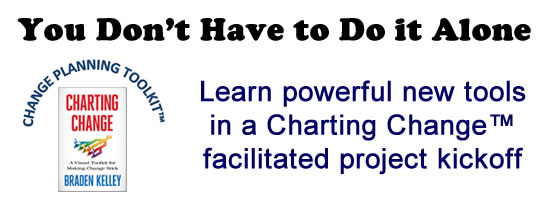Leading Innovation in the Digital Age

This is the third & final article on embracing digitization, transformation and innovation.
We are living in an era where that is defined by one continual exponential technology wave after another, called the Digital Age. It is transforming everything we do, from how we do business and especially in how we learn, lead and coach people. In fact, we have never seen a change of this scope and speed in human history, creating a seismic shift from an Industrial Age to the Digital Age.
After all, as we said in last month’s blog “Why mindsets matter in digital innovation and Transformation†that innovation is an organizations ability to stimulate and transform new ideas and knowledge into products, processes or services that tangibly increase value to customers, accelerate growth, enhance operational effectiveness and/or improve profitability. To do this, you have the best leaders and culture, digital architecture and mechanisms, flexible structure and systems in your organization to support and enable ongoing growth and innovation.
What is the Digital Age?
Some defining characteristics of the Digital Age, mentioned in the Digital Leadership EdEx course I am currently completing include:
- All information can be easily digitized, hence that data revolution.
- Digital devices that are fast, powerful, cheap, networked, and prevalent are in common use globally, hence radical changes in medical, biotech and fintech.
- The global network of people and devices enables anyone and anything to connect
- to anyone in the world, hence the need for teaming and networking across boundaries and geographies.
- Cheap storage (the cloud) and smart access tools connected by the broad-band, hence the internet of things.
- Internet enable rapid access to information by virtually anyone anywhere and the plethora of available information.
The Digital Age has unleashed three powerful forces:
- Continuous change in customers’ needs, priorities, and preferences, especially about what is of value.
- Ubiquitous (pervasive, expected to be everywhere, global) innovation: digitization tools enable an exponential increase in the speed of organizations’ ability to harness and apply new innovative technologies to bring products and services to market faster and align them with evolving customer needs. By quickly connecting on a global scale, people at any level can collaborate with colleagues, partners, or customers anywhere in the world to create better ways to do their work, or to co-create mutual value products and services that people value and cherish.
- Global markets, customers and competition: the pace of communication and ability to share information globally across customers and organizations means that new customer needs, new technologies, and new competitors can appear at anytime from anywhere in the world.
Organizations are complex adaptive systems
To maximize both the constraints and the possibilities emerging in the Digital Age, it is important to acknowledge that organizations are complex systems, rather than merely a set of complicated processes. Organizations are influenced by their environments, and conversely have an effect on the environments in which they function through new or refined products, services processes, or structures that are offered through their innovation or transformation efforts.
Suggesting that there is a duality existing between the people working within the organization and the broader organizational system of which they are a part, which can be described as a cognitive system. This in turn, influences how leaders think, act and make decisions. Making organizations cognitive systems that posses a unique cognitive architecture, which is expressed through its cognitive style, which then shapes a leader’s actions.
Making people matter
As we move further into the Digital Age, it appears that there is a greater disparity between an organization’s members and the organization perceived as an independent entity. People (talent and customers) now want more of a voice in how they are treated and how they are incorporated into the organization as a whole.
Making both management and leadership less of an “inside out†process, pushing products and services out to customers, and more of a “outside in†process, of pulling people and customers needs, wants and desires into the organization.
This requires the development of a new set of capabilities, to shift the cognitive system, re-scaffold the cognitive architecture and a cognitive style that embraces;
- Deep & dynamic learning
- Collaboration & co-creation
- Adaptive change
- Revenue growth & long-term sustainability through innovation
The Digital Age requires new Leadership Capabilities
There is a symbiotic relationship between leaders and the organizational system of which leaders are a part; leaders shape their organizational culture and it in turn, shapes how leaders focus their attention, their operating mindsets, behaviours, how they solve problems and make decisions.
Especially in their willingness to adapt, grow, learn and innovate when for producing value for the customer and drive success within their ever-expanding areas of influence and responsibility.
In our last blog  “Why mindsets matter in digital innovation and Transformation†we reinforced the need for organizations to focus on initiating a culture that supports digitization by strategically and systemically aligning the culture through the 4 OGI® mindsets; Imagine, Resolve, Analyse & Align ®Mindsets.
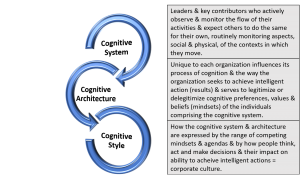
Figure 1
These represent the basis for understanding and describing an organization’s cognitive system, identifying its unique cognitive architecture, and measuring & contextualizing the impact of its operating cognitive style, as evidenced by how leaders currently thinking, acting and making decisions. This is illustrated in Figure 1.
Which of course, shapes the organizational culture both positively and negatively in terms of its ability to achieve intelligent actions to change, adapt, transform to achieve its strategic and revenue growth goals.
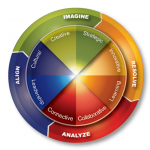
Figure 2
The OGI® measures organizational and employee mindsets, capturing the crucial emotional, intellective and volitional elements that other cultural tools overlook because it incorporates a multi factorial model within a holistic organizational assessment illustrated in Figure 2.
The 4 OGI® Organizational Mindsets also relate to eight specific factors, the OGI® Orientations, and the seven core Leadership Capabilities required to underpin success in the Digital Age.
Shifting leadership styles to adapt, grow and innovate
What is crucial to success is for the organization to develop the ability and the capacity to shift and target what is needed in each organizational context, to adapt and grow and deliver organizational strategic objectives. This is achieved by understanding the operating mindsets, and how they impact on the current organizational culture, as illustrated in the Figure 3 below, in our innovation culture case study introduced in last month’s blog.
Our Client Case Study Continued
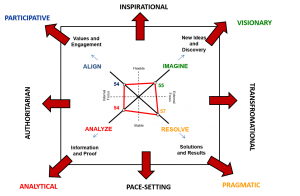
Figure 3
For our client to achieve its strategic intent and growth objectives, at a high level, it needed to cultivate stronger;
- Participative & inspirational styles of leadership to engage and cultivate people’s collective genius.
- Pace setting style to develop a more connected customer centric element towards adding value through innovation.
- Analytical style to see and solve problems to ensure consistent delivery of high quality products to salvage the brands reputation.
The emerging digital leadership paradigm
Adding to this, entrepreneurs are emerging as new role models & engaging in the art of harnessing human energy towards creating better futures embodying and enacting these capabilities through cultivating the following key roles that integrate cognitive, emotional and visceral elements illustrated in Figure 4.
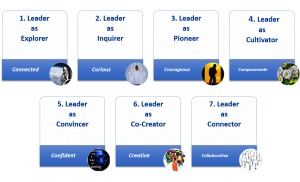
Figure 4
Integrating people, leaders, culture and the system
For an organization to succeed in the digital age it needs to intentionally and strategically ensure that the cognitive system, architecture & style get expressed by completing an initial cultural diagnostic incorporating the OGI® that;
- Measures and contextualizes an integrated summary (picture) of the Cognitive System & Architecture.
- Measures and contextualizes an integrated summary of the Cognitive Style (mindsets) & the 8 Specific Factors (orientations) that influence its ability to adapt & grow through the OGI®.
- Diagnoses and analyses the initial OGI® results & defines the Cognitive Style and its impact of the operating mindsets & orientations on revenue business & growth strategies.
- Aligns and describes the desired core cognitive, strategic & systemic changes & the gaps between the current and desired future states.
- Develops & implements change, leadership & learning strategies to achieve the desired cognitive style and corporate culture.
Making the commitment
As the Digital Age continues to evolve at a dizzying pace, organizations that are not keeping up, will continue to be disrupted by digital attackers and will not survive in today’s fragile macroeconomic environment. In our current VUCA times political and economic uncertainty are continuing to increase whilst company life expectancies are on the decrease.
What about hitting your pause button, and retreating and reflecting, as to what all of this means to your long-term sustainability?
What if you could immerse yourself in a long-term vision as to what could be and make the commitment towards understanding your cognitive system and architecture and cultivating a cognitive style that intentionally achieves intelligent actions that deliver your revenue, strategic, business & growth strategies, and long-term sustainability?
 At ImagineNation™ we provide innovation coaching, education and culture consulting to help businesses achieve their innovation goals. Because we have done most of the learning and actioning of new hybrid mindsets, behaviors and skill-sets already, we can help your businesses also do this by opening people up to their innovation potential.Â
Wait! Before you go…
Choose how you want the latest innovation content delivered to you:
- Daily — RSS Feed — Email — Twitter — Facebook — Linkedin Today
- Weekly — Email Newsletter — Free Magazine — Linkedin Group
 Janet Sernack is an ICF ACC accredited executive coach, corporate trainer, group facilitator and culture and change consultant with some of Australia’s and Israel’s top 100 companies. She is the Founder of ImagineNation™ an innovation education company that provides innovation e-learning programs including The Coach for Innovators Certified Program™ experiential learning events including The Start-Up Game™. Follow @JanetSernack
Janet Sernack is an ICF ACC accredited executive coach, corporate trainer, group facilitator and culture and change consultant with some of Australia’s and Israel’s top 100 companies. She is the Founder of ImagineNation™ an innovation education company that provides innovation e-learning programs including The Coach for Innovators Certified Program™ experiential learning events including The Start-Up Game™. Follow @JanetSernack
NEVER MISS ANOTHER NEWSLETTER!
LATEST BLOGS
Three things you didn’t know about credit cards
Photo by Ales Nesetril on Unsplash Many of us use credit cards regularly. From using them for everyday purchases to…
Read MoreFive CV skills of a business-minded individual
Photo by Scott Graham on Unsplash The skills listed on a CV help employers quickly understand your suitability for a…
Read More
